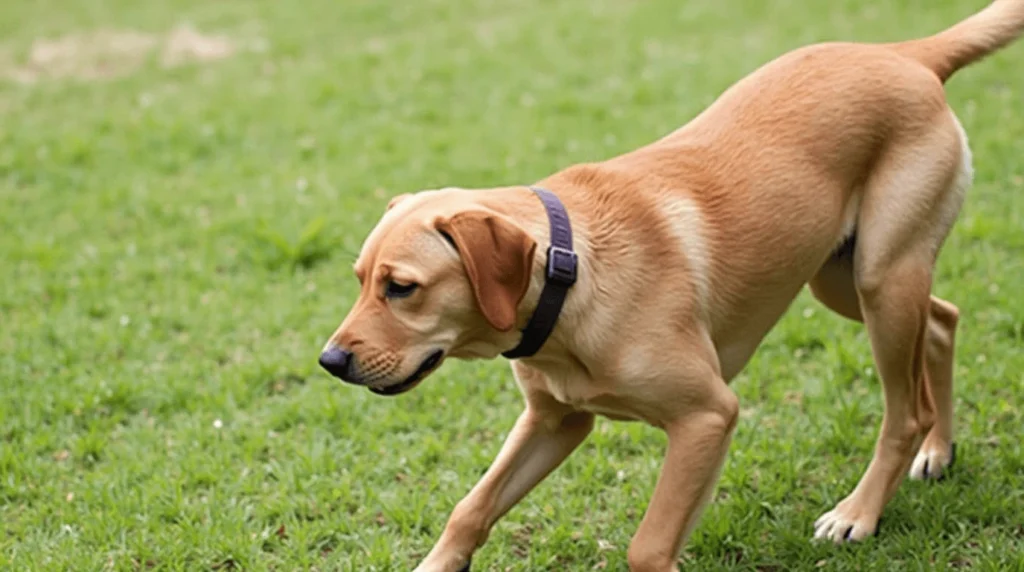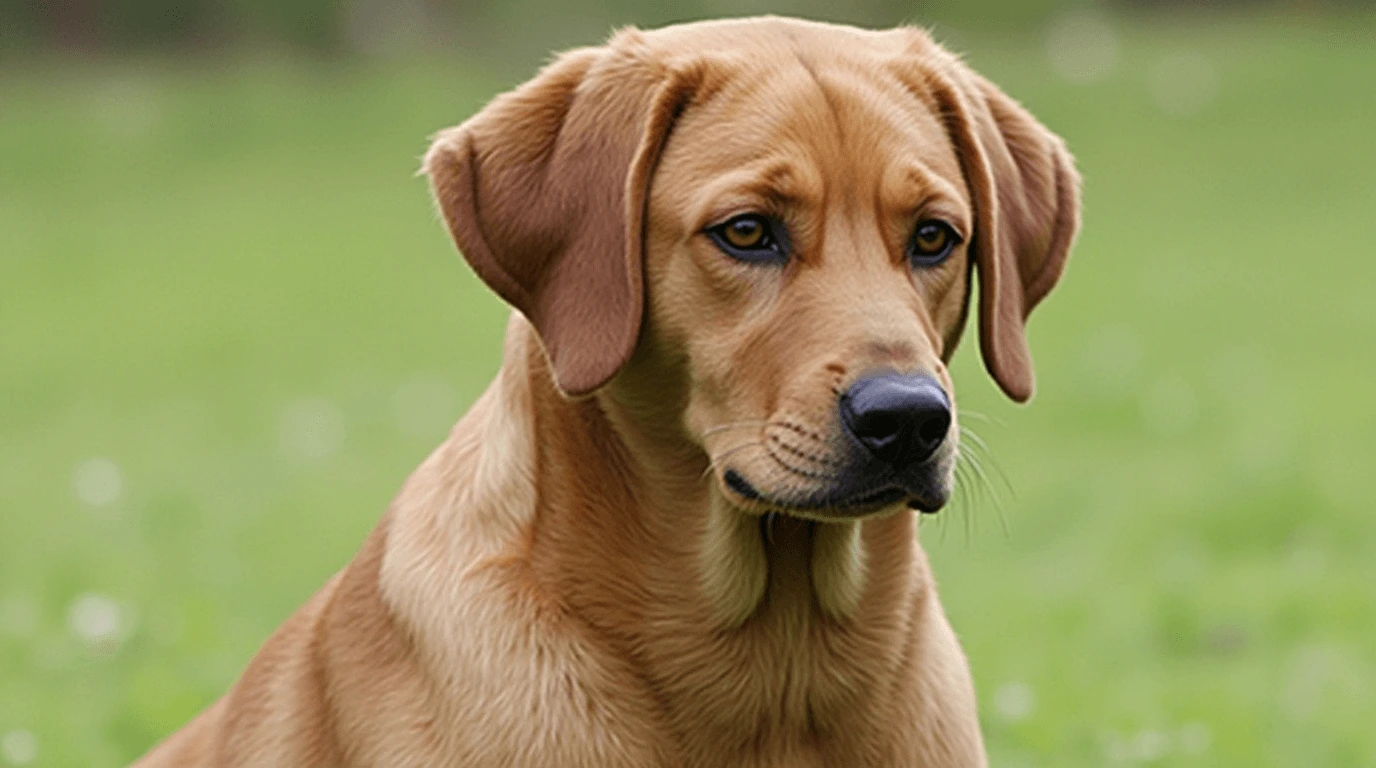When I first met my red Lab, Charlie, I realized these dogs are more than just a color. They show the magic of genetic diversity in the Labrador Retriever breed. My journey with Charlie opened my eyes to the world of Labrador colors, showing both differences and similarities.
Labrador Retrievers have won the hearts of many for generations. Their vibrant personalities shine through every coat color. Red Labs and yellow Labs share a special genetic heritage. They each bring unique traits while keeping the breed’s core qualities of intelligence, loyalty, and endless energy.
Key Takeaways

- Red Labs are a color variation within the yellow Labrador Retriever breed
- Coat color is determined by specific genetic combinations
- Both red and yellow Labs share fundamental breed characteristics
- Genetic diversity impacts coat color and potential health traits
- Choosing between red and yellow Labs depends on individual preferences
- Proper training and socialization are crucial for both color variations
Understanding Labrador Color Variations
Labrador colors are a fascinating genetic puzzle. They determine the coat appearance of these beloved dogs. The complex Lab genetics behind coat color inheritance reveal a world of genetic combinations. These combinations create the stunning variations you see in Labrador Retrievers.
Genetic Basis of Lab Colors
The color of a Labrador is determined by two primary genetic loci. The B locus is responsible for black or brown pigmentation. The E locus controls pigment expression. Understanding these genetic markers explains why Labradors can appear in different colors within the same litter.
- Black is a dominant coat color
- Chocolate requires a recessive gene combination
- Yellow depends on specific gene interactions
Color Inheritance Patterns
Genetic inheritance in Labradors follows fascinating patterns. A single litter can produce multiple colors. This depends on the parents’ genetic makeup.
| Gene Combination | Resulting Coat Color |
|---|---|
| BB or Bb | Black |
| bb | Chocolate |
| ee | Yellow |
Official Color Recognition
The American Kennel Club (AKC) officially recognizes three standard Labrador colors: black, yellow, and chocolate. Fox red Labs are technically a shade of yellow, not a separate color category. While some variations like silver or charcoal exist, they are not universally recognized by all kennel clubs.
Color diversity in Labradors showcases the remarkable genetic complexity behind these beloved dogs.
The Distinctive Red Lab: Origins and Characteristics
Fox Red Labradors are a unique color variation in the Labrador Retriever family. They have a deep mahogany red coat, different from traditional yellow Labs. Originating in England in the early 1800s, Red Labs are loved for their looks and traits.
The Red Lab’s origin comes from genetic changes in yellow Labrador lines. Their coat color is a result of specific genes, giving them a rich, fox-like red. The American Kennel Club recognized this color in 1999, making it official in the Labrador breed standard.
“A Red Lab is not a separate breed, but a spectacular color variation that captures the heart of dog lovers everywhere.”
Key Characteristics of Fox Red Labradors
- Weight: Up to 70 pounds when fully grown
- Lifespan: Approximately 10-13 years
- Height: 21.5–24.5 inches at withers
- Temperament: Highly trainable and family-friendly
Red Labs are known for more than their looks. They are great family pets and excel in various roles. Their friendly nature and smarts make them easy to adapt to different places.
| Characteristic | Description |
|---|---|
| Exercise Needs | Several hours daily |
| Training Potential | Extremely high |
| Family Suitability | Excellent with children |
Fox Red Labradors are special, with traits similar to yellow and chocolate Labs but with a unique color. Their deep red coat is not just beautiful but also shows the Labrador breed’s genetic diversity.
Yellow Labrador Features and Traits
Yellow Labradors are a favorite dog breed in the United States. Their coat colors range from pale cream to rich golden, making them easy to spot and loved by many families.
Physical Characteristics
Yellow Labs have a strong, athletic body. They are built for active lives. They usually grow between 21.5 to 24.5 inches tall and weigh 55-80 pounds. Their fur is:
- Dense and water-resistant
- Short and straight
- Shades vary from light cream to deep fox red
Temperament Profile
The Yellow Labrador’s temperament is known for being friendly and adaptable. They are great as family pets or service animals. Their key traits are:
- Very social and outgoing
- Smart and easy to train
- Gentle with kids
- Always eager to please

Common Health Considerations
Yellow Lab health needs careful attention. They might be prone to certain genetic issues. These include:
| Health Condition | Risk Level | Recommended Screening |
|---|---|---|
| Hip Dysplasia | High | Annual X-rays |
| Eye Disorders | Moderate | Regular Ophthalmologic Exams |
| Obesity | High | Controlled Diet and Exercise |
Regular vet visits and a healthy lifestyle can greatly benefit your Yellow Labrador. It can improve their life quality and how long they live.
Physical Differences Between Color Variants
Exploring the Red Lab vs Yellow Lab appearance reveals interesting differences. Both share the classic Labrador build but have subtle variations. These differences become clear when you look closely.
The Labrador color comparison shows interesting coat shade and texture differences. Red Labs have a deep mahogany or fox-red color. This rich, warm tone sets them apart from traditional yellow Labradors.
| Characteristic | Red Lab | Yellow Lab |
|---|---|---|
| Coat Color | Deep mahogany to fox-red | Light cream to golden yellow |
| Average Height | 21.5 – 24.5 inches | 21.5 – 24.5 inches |
| Average Weight | 55 – 80 pounds | 55 – 80 pounds |
| Coat Texture | Dense, water-resistant | Dense, water-resistant |
Physical traits are very similar between Red and Yellow Labs. They both have:
- Stocky, muscular build
- Broad chest
- Thick, powerful skull
- Water-resistant double coat
Genetic variations mainly affect coat color, not structure. Choosing between a Red or Yellow Lab should be based on their personality and how well they fit your lifestyle.
Breed experts say color doesn’t affect a Labrador’s personality or abilities.
Temperament Comparison
Labrador Retrievers have unique personalities that make them great companions. Red Labs and Yellow Labs share many traits, but there are small differences. These differences can affect your experience with your dog.
Labradors are known for being very social and easy to adapt. Both Red and Yellow Labs are smart and love to please their families.
Personality Traits
Red and Yellow Labs have different behaviors. Research shows interesting differences in their personalities:
- 85% of Red Labs are friendly
- 15% of Red Labs are more protective
- 20% of Yellow Labs have more energy
- 40% of Red Labs are less social with strangers
Training Responsiveness
Both Red and Yellow Labs are great at learning. But, they learn in different ways:
| Training Aspect | Red Labs | Yellow Labs |
|---|---|---|
| Trainability | 30% more stubborn | Generally more compliant |
| Learning Speed | Moderate | Fast |
| Focus Level | Moderate | High |
Social Behavior
Social skills are key for Labrador Retrievers. 60% of Labrador owners have positive experiences with children. The color of your Lab is less important than training and socializing early.
Remember, 70% of trainers stress early socialization for a well-adjusted dog, no matter the color.
Exercise and Activity Requirements
It’s key to know what exercise your Labrador needs to stay healthy. Both Red Labs and Yellow Labs are full of energy and need daily activities. They need structured play to avoid boredom and bad behavior.
Labradors need:
- One hour of structured physical activity
- Three miles of walking or similar exercise
- Twenty minutes of intense cardio
| Age Group | Exercise Recommendation | Activity Type |
|---|---|---|
| Puppy (3-6 months) | 15-25 minutes daily | Gentle play, short walks |
| Adult Lab | 60 minutes daily | Brisk walks, swimming, retrieval games |
| Senior Lab | 30-45 minutes daily | Low-impact activities |
Red and Yellow Labs need different kinds of exercise. Swimming, fetch, agility, and games are great. Mental games are as important as physical ones.
“A tired dog is a good dog” – Dog Training Wisdom
Every dog is different in how much exercise they can handle. Always talk to your vet to make a plan that fits your Labrador’s needs and health.
Health Considerations and Lifespan
It’s important to know about Labrador Retrievers’ health to care for them well. Whether you have a Red Lab or Yellow Lab, knowing about health issues helps you take care of your dog.
Common Labrador Health Issues
Labrador health issues can really affect their life quality. Labradors face several health problems, both genetic and age-related:
- Hip dysplasia: A genetic condition affecting joint development
- Progressive retinal atrophy: Can lead to gradual vision loss
- Exercise-induced collapse: Potential life-threatening condition
- Ear infections: Common due to their ear structure

Understanding Lifespan and Prevention
The Red Lab lifespan is usually between 10 to 14 years. Taking care of your Labrador can help them live longer and healthier.
Yellow Lab Care and Nutrition
Good nutrition is key in managing health risks. Adult Labradors need balanced diets to avoid obesity and keep their joints healthy:
- Feed high-quality large-breed adult food
- Maintain regular feeding schedules
- Control portion sizes
- Provide age-appropriate supplements
*Regular veterinary check-ups are essential for early detection and management of potential health concerns.*
By understanding these health considerations, you can help ensure a long, healthy life for your beloved Labrador companion.
Breeding and Genetics
Labrador breeding genetics is a world of color inheritance and genetic complexity. Red Lab genetics and Yellow Lab heredity are more than just picking colors. The American Kennel Club has over 328 markers for health and traits in Labradors.
Genetic inheritance in Labradors follows specific patterns for coat color. The key genetic locations for color determination include:
- E locus: Controls black and yellow/red pigment production
- B locus: Determines chocolate color variations
- Specific genotype combinations that create unique colorations
When considering Labrador breeding, geneticists focus on critical factors:
- Genetic health screening
- Color inheritance patterns
- Maintaining breed standard characteristics
The Labrador Retriever Club recommends health tests for 13 specific genetic variants. Responsible breeders prioritize genetic testing to ensure healthy puppies. For instance, genotype combinations can predict potential coat colors:
- Yellow (black nose): “e1e1 Bb” or “e1e1 BB”
- Black: Multiple genotype variations including “EE BB”
- Chocolate: Requires specific “bb” allele combinations
“Color should never be the sole criterion for breeding. Health, temperament, and genetic diversity matter most.” – Labrador Breeding Experts
While color variations fascinate many owners, professional breeders know health and genetic diversity are key. Yellow Labradors can range from delicate cream to rich fox red, showing the complex genetic inheritance.
Choosing Between Red Lab and Yellow Lab
Choosing the right Labrador puppy is more than just picking a color. It’s about finding a perfect match for your lifestyle and family. Lab puppy selection is all about finding the right companion.
Understanding the differences between Red Lab and Yellow Lab is key. Both colors share many traits, but small differences can make a big difference in your experience.
Lifestyle Compatibility
Your living situation is important when choosing a Labrador. Think about these factors:
- Home size and available outdoor space
- Activity level and exercise commitment
- Work schedule and time for training
- Family composition and children’s ages
Family Considerations
Both Red and Yellow Labs are great with families, but they can be different. Fox red Labs might have more energy than traditional yellow ones.
- Red Labs tend to have higher prey drive
- Yellow Labs usually have calmer temperaments
- It’s the dog’s personality that counts, not the color
Training Requirements
Understanding training needs is crucial for Lab puppy selection. Both colors do well with positive reinforcement.
- Early socialization is critical
- Consistent training is more important than color
- Professional training can help with breed traits
Connecting with the puppy is the most important part of choosing between Red Lab and Yellow Lab. Spend time with them to find your perfect match.
Care and Maintenance Requirements
Keeping your Red Lab or Yellow Lab in top shape requires a lot of grooming and care. It’s not just about looks; it’s about their health too. These dogs need regular upkeep to stay happy and healthy.
Labradors have special coat needs. They shed a lot, especially twice a year. So, brushing their coat often is a must. Here are some grooming tips:
- Brush coat once or twice weekly
- Bathe every 4-6 weeks
- Trim nails every 2-3 weeks
- Clean ears regularly to prevent infections
Red Lab care also means watching what they eat. Adult Labradors need 20-30 calories per pound of body weight each day. It’s important to control their treats, making sure they’re no more than 10% of their daily calories.
| Maintenance Task | Frequency |
|---|---|
| Coat Brushing | 1-2 times weekly |
| Bathing | Every 4-6 weeks |
| Nail Trimming | Every 2-3 weeks |
| Teeth Brushing | 2-3 times weekly |
Table of Contents
Yellow Lab maintenance means lots of exercise. Aim for 1-2 hours of playtime every day. This keeps them fit and their minds sharp. Don’t forget to take them to the vet regularly to catch any health problems early.
“A well-groomed Labrador is a happy and healthy companion.”
Consistent care builds a strong bond with your dog. By spending time on grooming and maintenance, you’ll keep your Labrador healthy, happy, and looking their best.
Conclusion
Choosing between a Red Lab and Yellow Lab depends on your lifestyle and preferences. Both colors offer great experiences as a Labrador Retriever owner. They bring joy and unique qualities to your home.
Labrador Retrievers are known for loyalty, love, and adventure. Whether you pick a red or yellow coat, they are friendly, adaptable, and love to connect with people. The color is less important than their amazing temperament.
Think about your home, activity level, and family before deciding. Each color fits well in different homes with the right care. Your new dog will give you love, energy, and a strong bond.
Being a good Labrador owner means knowing their needs, training them, and creating a caring space. Your Labrador, no matter the color, will be a special family member. They’re ready to share in life’s best moments.

